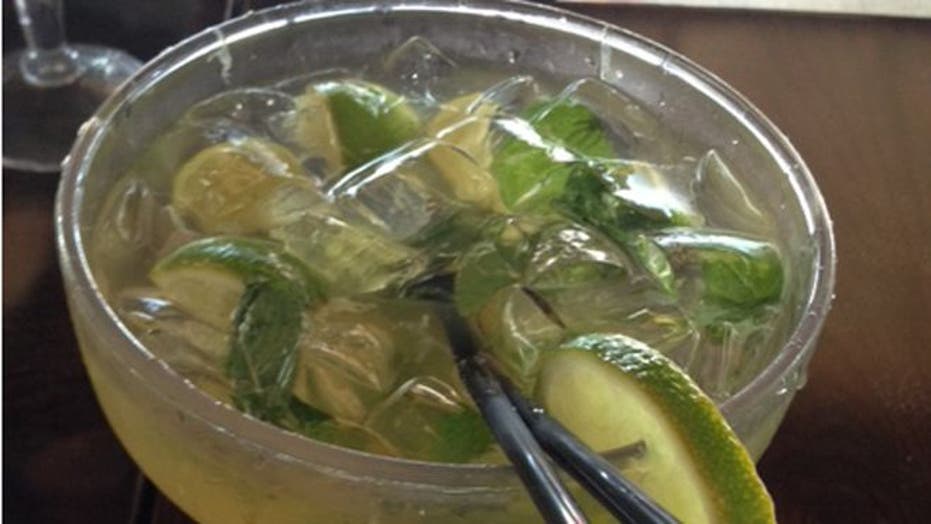The sky is blue. The breeze is mild. The temperature is hovering around 92 degrees, and out here on the wood-plank deck of Dockside Sea Grille, the mood is right: It’s mojito time.
Luckily, this is Lake Park, Florida, and not New York City, where a number of bartenders in the city that never sleeps have vowed that they will never mix another mojito. The drink is “messy” and “time-consuming” to prepare, one bartender told the New York Post last week, and, so, the newspaper said, a number of barkeeps are “revolting against the mojito masses.”
That’s a revolting development in the eyes of South Florida bartenders.
“Yeah, we serve mojitos, serve them all the time,” says Albert López, who tends bar and waits tables at the Dockside. “I guess it goes with the weather. People enjoy them.”
Lots of people. Mojitos are muy popular here.
“Very popular,” Lopez confirms. “A little under half of the people have ‘em a lot. And once they have one, they just don’t stop.”
He actually enjoys making mojitos, he says – and adds his own touch, a splash of triple sec, to the standard combination of rum, lime, muddled mint, sugar syrup and club soda – but he withholds criticism for his New York brethren. “I’m sure they get a lot of drink orders thrown at ‘em,” he says, “so I understand. When you’re slammed you hate to hear ‘Three mojitos.’ But it’s worth the time.”
Thirty miles to the south, at the Sandbar in Delray Beach, server Lexa Berman shakes her head at the bartenders’ ban in New York. Sure, weekends can get crazy busy here, she says, “But a classic mojito? That’s like not serving margaritas because you don’t want to salt the rim.”
Bartender Katie Rosenburg agrees. What does she do when a crowd clamors for mojitos?
“I take a deep breath and muddle,” she says. “I mean, it’s definitely tough when you're very, very busy, but it’s really not as big of a pain as people make it out to be. I put it down to laziness. I mean, you’re a bartender, a mixologist. It’s part of your job.”
She waves an arm at the bar area behind her – it nestles beneath an oversized chickee hut, an open-air Seminole Indian-style palm-thatched structure – and notes that there are two stations set aside specifically for mojito-making.
“They’re very popular for our bar,” she says. “Most definitely. Because we’re right across from the beach and it’s a beach drink.”
The Massachusetts-based business website Havana Journal cites competing accounts of the mojito’s origin. One credits 19th-century slaves working in Cuban sugar fields with creating the drink. A more widely circulated story, one promoted by Bacardi Rum, traces its derivation back several more centuries to the attempted sacking of Havana by Francis Drake and his pirates. The 1586 grab for gold failed, apparently leading Drake’s associate, Richard Drake, to drink: He reputedly created a concoction made from mint and lime and aguardiente, a pre-rum inebriant, and dubbed “El Draque.” Once the Bacardi company came along in the 1800s, rum was substituted as the main ingredient.
The aficionado most closely linked with mojitos is Ernest Hemingway, who drank them at Havana’s La Bodeguita del Medio and famously wrote, “Mi mojito en La Bodeguita” on the bar’s wall. (He downed his daiquiris at Havana’s La Floridita.)
Far more recently, Dave and Pam Snyder of Ft. Washington, PA, were enjoying their mojitos at the Sandbar in Delray Beach. His, a strawberry mojito; hers, a cosmojito.
The Snyders view New York’s no-mo attitude as running counter to the city’s vaunted image: the place where anyone can get anything at any time.
“I would think that’s not right,” says Pam Snyder. “It’s like, you go someplace to enjoy yourself. Mojitos are refreshing. We’re hot. We’re tired, because we just got here. This is what we wanted.”
Many Miamians share that particular thirst. A Cuban restaurant called Mojitos, in Miami’s northwest reaches, specializes in, well, what else?
Visitors to the eatery’s website leave ratings of varying degrees of enthusiasm, but the namesake drinks get across-the-board raves. A typical entry: “I started off with a classic mojito and this was my first time ever having one. It was good, I like. I had nothing to compare it to, so naturally it was the best I ever had. After gulping down the first, I next decided to try a strawberry mojito. This one was even better than the first. Following strawberry was a mango mojito and from what I recall, this was pretty good too.”
So it’s reasonable to think that mojitos are pretty popular? “One hundred percent popular,” says manager Julio Fuenmayor. “It’s our signature drink.”
On a typical Friday or Saturday night, he says, Mojito’s bartenders make about 300 of them. And, yes, they require a bit of fussing.
“Well, the thing is, if you’re going to make a mojito, you have to make a good one, and that takes time,” he says. “But New York, it isn’t Latin at the heart. We have the Cubans here, and they love mojitos.”
Christian Hopper, a manager at YUCA, which calls itself South Florida’s original upscale Cuban restaurant, worked as a Miami Beach bartender for 10 years, and he understands why a harried bartender would rather serve a simple club soda and vodka. Still, he says, “a lot of bartenders see it as a way to show off their skill.”
Not surprisingly, the Miami Beach-based YUCA, an acronym for Young Urban Cuban-Americans , prides itself on its mojitos – and on its preparation shortcut, which involves pre-mixing ingredients in a blender and adding them to the rum.
But the last word on the subject must go to Dave Snyder, drinking at Delray’s Sandbar.
“If I go into a bar anywhere and a bartender says anything’s too much trouble to make,” says Snyder, hand wrapped around his strawberry mojito, “then I don’t want to be in that bar.”

